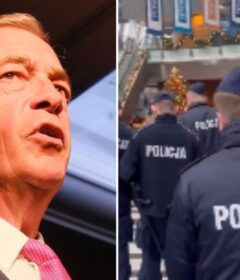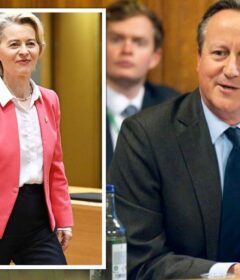Claire Trevett: Camp Covid’s final 48 hours – the inside view of how police moved protesters
OPINION:
After something big, little details remain.
A policeman tripping over a solitary sandal on the chalked driveway. The reek of wet ash. The pile of police hats piled up at the base of the Kate Sheppard pedestal in Parliament’s front foyer.
A massive pile of pizzas wheeled up Parliament’s front driveway by a police officer.
Someone had referred to the police action to clear the protest grounds as Operation Haere Ra. I never found out if that was an official title, but it will do.
Wednesday – the day the police moved
For the first five hours, there was a weird disjunct at the protest referred to as “Camp Covid”.
Around the perimeters, police were moving in, pepper spray and smoke bombs were being used, there were arrests and loudhailers used by both sides, one urging “hold the line” and the other calling on protesters to leave and to back away from the police line.
The “move, move, move” chant of police pushing back through a crowd was the soundtrack. Police cleared people and collapsed the tents around the Parliamentary Library and St Paul’s Cathedral first.
There was pepper spray and yelling.
But in front of Parliament itself, on the main lawn, songs of peace were being played – Amazing Grace, Alleluia, a bit of Bob Marley. The yoga crew stood and did their stretches.
The national anthem played, and at one point the Last Post rang out. There was a lull of silence after it finished, a pause, before the police speakers rang out again with their warnings to leave.
When things got really heated on the outskirts, the music within changed to meditation music and a man spoke over it, using a slow, calm voice.
There was the thin line of police, a few protesters yelling their now routine abuse at both police and media, telling them to sack themselves, that they were useless.
But there was no real indication those people directly in front of Parliament thought the police would be coming for them next.
But they did.
After a lull for a couple of hours, just as people wondered if they had stopped for the day. The police moved. It was sudden. A massive swarm of riot police in full body armour came out first, sprinting up the ramp of the driveway that leads from the underground car park.
A massive cloud rose as they ran: the protesters had clearly suspected and turned fire extinguishers on the swarm. Police had given the protesters the fire extinguishers a few days earlier, concerned about the risk of a fire in the camp.
Then it began: thick lines of police moving through the protest area, pushing it further and further back. It was like watching a tank go through: people pushed forward and the tents being flattened and spat out the back.
The best way I could come up to describe the satisfaction of watching that was vacuuming your floor when it is very dirty.
At first, it seemed remarkably quick and easy. The trouble hit at about the halfway point, just before the Richard Seddon statue, now with graffiti and a splash of purple paint on it.
Horrified media looked on, those based in the crowd hurtling back so they weren’t caught in between the two lines or in the path of an exploding LPG bottle.
Horrified MPs were also watching by now, some on livestreams and some through windows.
Some had smelled the smoke inside the debating chamber. Prime Minister Jacinda Ardern was in her office on the 9th floor of the Beehive when she saw the smoke coming up. She did not have a clear view so went down to Minister Chris Hipkins’ office, two floors below, to watch as the playground fire burnt.
She later said she felt “sad.” Another MP came to the balcony later that night after it was over. She started crying as she looked over the now-abandoned lawn and was told how the operation had rolled out.
She said that she had only ever cried twice in the years she had been at Parliament: the other time was after the March 15 mosque terror attacks.
The original police plan was to clear the protesters out over three days, in stages.
But what had happened at the library and on the perimeter had done two things. In the police’s favour, a lot of protesters and cars on Molesworth St left rather than stay and fight. That had largely cleared the street and opened the way for police.
Among those left, it had resulted in an atmosphere akin to a hornet’s nest that had been poked.
There was an angry buzz. The day before the police had seen how angrily some protesters had reacted even to the removal of a mobile shower unit on the outskirts of the protest.
Police clearly decided they could not afford to wait and let the protesters bring in reinforcements or give them time to build an arsenal for the fightback. So it was done in one day.
The leadup
Senior sources have said that one reason police had not taken firm action earlier was because they simply did not have the numbers needed to be sure of success.
On the first day of the protest, there were few police around. When Parliament asked police for protection while its own security cleared away the few tents that were erected, police said no. They did not have enough officers available for it. They had clearly underestimated the protesters’ determination.
By the time they stopped under-estimating it, it was too big.
Police Commissioner Andrew Coster took the only decision he could have at that point, opting for de-escalation rather than force. He had to stick with it even after it became blatantly obvious that the protest was not going to be resolved by a daily episode of Moving Blocks.
The early attempt by Police to move protesters by force on the third day of the protest had failed. They did not have enough police to see it through.
By the end of the second week it was blatantly obvious constructive talks with the so-called protest leaders were not working and would never work.
The police were now starting to look like laughing stocks. They had managed to stop protest vehicles entering by blocking off the streets, but the protest was not shrinking and the protesters were taking the piss more and more.
The installation of a toilet block, fully plumbed, by the protesters was the last straw for some, furious police were not managing to stop such things.
Two days earlier, police assistant commissioner Richard Chambers had assured people they would only let the essentials through the cordons: no more tents or building equipment.
It remains unknown how many pup tents the police confiscated after that statement was made.
But they somehow managed to miss a raft of porcelain toilets, plumbing pipes, and the massive sheets of plywood that were used to construct a toilet block. They also missed a trampoline and a table tennis table. A mobile shower block was moved up, albeit it outside the police cordon, and so police did manage to move that the same night.
Nor were Wellingtonians soothed by the “reassurance patrols”.
But what they had done over that period was shrink the protest, both in terms of numbers and the ground it occupied. That was partly police strategy, and partly simply the passing of time as some left to return to other duties.
The action that unfolded on Wednesday was the result of a lot of planning. There was the logistical planning to pull in all the police needed at the same time.
The sheer numbers involved – about 600 – was about three times the number usually on deck.
They came from all over the country, ranging from special tactics teams and armed offenders squads to new recruits. The decision to scale back MIQ also helped: police that were due to go on to MIQ duties were now free.
Word police might finally be taking things beyond “reassurance patrols” and a daily rearrangement of concrete blocks had filtered through a day or two earlier.
There were noticeably more police around and a lot of vans. Any fool could see something was coming.
On the night before, a message was put on to the protesters’ online message channel, warning that the police would move from 4.45am, that they would move in on all flanks.
Coster later dismissed that as “speculation” rather than a leak – but it was accurate enough.
There were many theories: whether it was a deliberate leak to try to psyche out the protesters (it certainly got them worried) or as advance warning, hoping at least some would leave in advance. Or whether a sympathetic cop had leaked it to them to give them time to prepare.
The police had also been preparing – for at least a week beforehand. They had clearly considered that they might not necessarily win.
Protesters had heard drilling inside Parliament’s library building. That building was considered to be a weak point by police: the place protesters could more easily break into, and move from there over to Parliament House.
It is why police secured the library building before anything else on Wednesday morning. The drilling the protesters had heard was steel bars and doors going in inside, to try to stop any storming of the building. The same happened in Parliament House.
A massive steel door was bolted into the wall over the doorway between the Parliamentary library and Parliament House as a further obstacle if the protesters made it in.
When Coster opted to take the “de-escalation” approach rather than a show of force, he said that resorting to force would get very ugly very quickly.
He was right, although it could have been much uglier.
It is to the credit of the police involved that it was not. The most serious known injuries were to police officers: a brick was thrown at one so hard it broke his leg. Another took one to the head, and was seen being escorted back up to from the front lines with blood streaming down from his forehead. I ran into him the next day as he left the police rapid antigen testing zone. His face was swollen and cut and looked painful. I asked if he was okay, and he said with delight “yes, I passed my RAT.” Small wins.
Behind the scenes: Inside Parliament
$60,000 worth of coffees and hot chocolates.
That is what it took to fuel the police, hundreds on any given day, at Parliament’s cafe, Copperfields, over three weeks.
They initially went onto the Speakers’ bill, then Parliamentary Service’s.I don’t begrudge them a single coffee. The pie warmer was never full for long.
The queue of police at Copperfields replaced the public and many of the staff. Others working in the building were wise to work out when the shift changes were to avoid the queues. Copperfields ended up staying open until midnight, and re-opening at 5.30am to cater to them.
As time passed, like the protesters, the police too made themselves a bit more at home. A Connect Four game appeared in the waiting area one day, and other things to pass the time.
The police were based on the ground floor of Parliament, the same as the Press Gallery offices. There were queues of police waiting for RATs, police jackets and power drinks scattered about while their owners stood on shift outside.They took over the Grand Hall, usually used for functions, for briefings.
On Friday the doors were open and a whiteboard still held the map of Parliament grounds that had been used for the briefing ahead of Wednesday’s move.
Soon, like the protesters, the police will be gone from Parliament.
On Wednesday, a triangle of society came together at Parliament.
There were lawbreakers outside, the lawmakers inside, and law enforcers sorting it all out.
In the middle watching and filming for the rest of the country were the journalists.
Few of the journalists who have been at Parliament for the past weeks would have been able to be objective. I certainly was not.
I was Team Police on that day. I have to admit watching the police plough through the protest ground, flattening tents and clearing the protesters out ahead of them was deeply satisfying after three weeks of a life feeling on edge.
It had become obvious Covid-19 was running through the protest camp after the first two weeks of the protest. The police were the first known cases, then the media started getting it.
Media trying to cover the protest effectively had a choice: either risk getting abused and bashed, or risk getting Covid-19.
Journalists could take off masks and go low-key to try to avoid being abused and attacked by protesters, or keep on their masks and be easier targets. It was even harder for those with cameras.
In that third week, four of our staff who had worked in the protest camps got Covid-19, as did several other media. Others were threatened and shoved.
Even when protesters talked – and several of them did – the other difficulty journalists had was the balance between letting them have their say, without being a tool to spread misinformation.
Publishing different opinions on established facts is one thing, opinions on things that are not facts are another.
I have worked at Parliament for 15 years, longer than most MPs (but nowhere near as long as a few).
I love a good protest. I didn’t even mind this protest in its beginning days. It was fascinating.
It was not all bad then. But it was bad by the end.
I have never seen anything remotely like what I saw unfold on Thursday.
It will be a long time before I forget the three weeks that came before it as well.
It is always significant to watch history happen, no matter how gritty it may be or difficult to make sense of, and that was history. But I hope like hell it was not also precedent.
At sunset on Wednesday night, I went back up to the balcony overlooking the lawn.
There was a kererū in the cabbage tree in front of the balcony. Two elderly Māori sat quietly in a tent, the only two protesters to escape the police swathing through.
A while later some police officers gently walked them out.
Long lines of police started walking back up Molesworth St from Victoria University’s Pipitea campus and the railway station below, the scene of the last standoffs with protesters.
They came in their black body armour and the usual blue uniforms, great long lines of them.
As they walked up, the residents of apartments opposite cheered and clapped and shouted “thank you” to them, over and over, for each group.
It was over.I have to admit I cried.
Source: Read Full Article
/cloudfront-ap-southeast-2.images.arcpublishing.com/nzme/B22YVCTTQ2PO3JE6IAO6NG6TP4.jpg)
/cloudfront-ap-southeast-2.images.arcpublishing.com/nzme/WJALG2W2QPHBQBTY7UXSFAUOHU.jpg)
/cloudfront-ap-southeast-2.images.arcpublishing.com/nzme/NRNAFG2GOZBEOKFSNM3MB7HU3I.jpg)
/cloudfront-ap-southeast-2.images.arcpublishing.com/nzme/47OSAJEFVV7GYOCLL7EE3PJRIY.jpg)
/cloudfront-ap-southeast-2.images.arcpublishing.com/nzme/3KVTSXWTDCJQKQLBGWQRMBOBDY.jpg)
/cloudfront-ap-southeast-2.images.arcpublishing.com/nzme/RE4ZVJLDAIFBANZAHEBEZ22IU4.jpg)
/cloudfront-ap-southeast-2.images.arcpublishing.com/nzme/RCGCZLXMGRCTK6UEMPWDXU5TIM.jpg)
/cloudfront-ap-southeast-2.images.arcpublishing.com/nzme/JHYHI2ASAZN2E2C7FYVN4NT5RQ.jpg)
/cloudfront-ap-southeast-2.images.arcpublishing.com/nzme/PJPVDQKOMII6I2TBA2SSXOXQGI.jpg)
/cloudfront-ap-southeast-2.images.arcpublishing.com/nzme/FVGMJVAN54VYVXB76QL57IN4TI.jpg)


